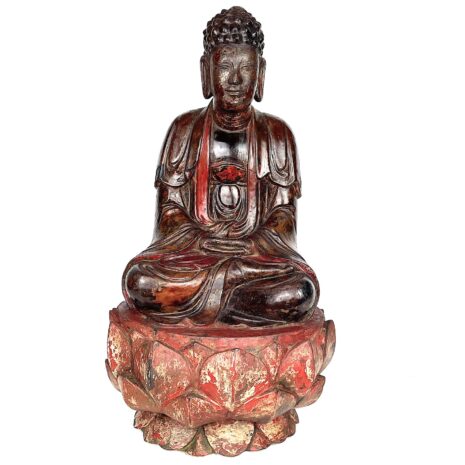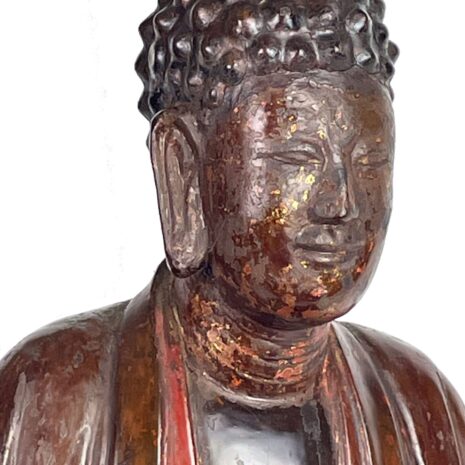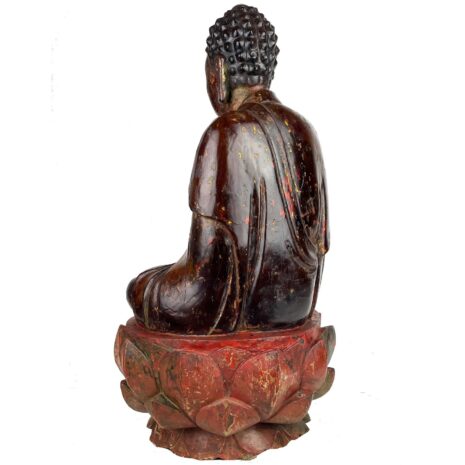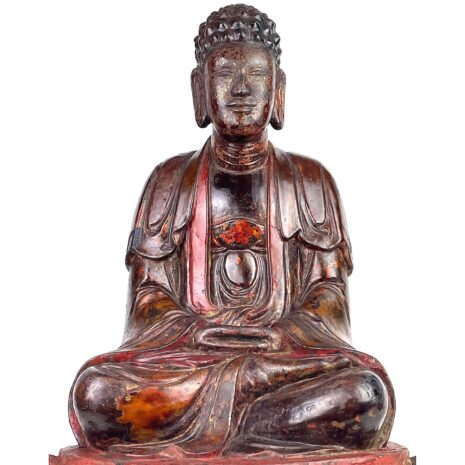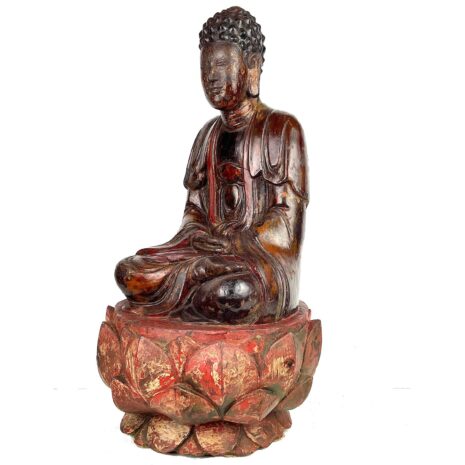Ming Shakyamuni Buddha on Lotus Pedestal, China, (16529)
Original price was: $3,750.00.$2,985.00Current price is: $2,985.00.
H:18.75“ W: 9.75″ D: 9″ | CALL 213-568-3030 OR EMAIL [email protected] FOR SHIPPING.
Magnificent rare Ming Buddha covered with dark lacquer, indications of gold and red pigmentation. Seated in meditation on an elaborate lotus throne, this rare masterpiece would enhance any environment with its spiritual energy and beauty.
Description
Although there have been countless Buddhas, only Shakyamuni is considered The Buddha, the historical figure who lived on earth and was the source and creator of Buddhist doctrine. He is the principal and fourth Buddha of the present era who will be succeeded by the Buddha of the Future Maitreya (Mi-lo-Fu in Chinese) in three thousand years.
This magnificent Mahayana Buddhism carving is depicted in his most commonly represented pose seated in meditation (dhyana) legs placed in lotus position (padmasana) with bare soles of feet turned upward and resting on the opposite thigh. The thumbs touch forming a triangle symbolizing the Three Jewels of Buddhism (triratna): the Buddha, the dharma (Buddha’s teachings) and the sangha (religious community) Made to be viewed in the round, his three part monk’s robe cascades in folds revealing the lower garment gathered at the waist with the shawl over his shoulders extending to his back. He gracefully sits on beautifully carved lotus throne (padmapita) with three rows of lotus leaves. Many of the Buddha’s identifying features (lakshanas) are depicted: pendulous ears symbolizing enlightenment, three neck creases symbolizing luck and a raised cranial protuberance (ushnisha) denoting the seat of intellectual powers, wisdom and divine energy. The ushnisha is centered with an hemispherical bump (nikkeishu) that represents his radiating light of wisdom. His “snail-crowned” head with raised rounded spiral curls, is an allusion to the legend that lost in meditation he was unaware of the sun beating on his head. In gratitude for his love for all sentient beings, snails gathered on his head to form a protective hood
In excellent condition, covered with lacquer coat and licks of gilt that enliven his red painted throne this is a rare and beautiful statue, as many Ming Buddha images did not survive ravages of time or China’s modernization.
The meditation pose itself represents perfect physical and spiritual balance and is said to be derived from the position the Buddha assumed when meditating under the Bodhi tree before his enlightenment. This brilliant carving captures that moment perfectly as he radiates serenity with a with his beautiful benign expression. This exquisite spiritual representation is one of our favorite works of art.
Sources:
Fredrick W. Bunce, A Dictionary of Buddhist and Hindu Iconography, New Delhi, D. K. Printworld (P) Ltd., 2001.
Patricia Eichenbaum Karetzky, Images of Asia: Chinese Buddhist Art, New York, Oxford University Press, 2002.
Meyer McArthur, Reading Buddhist Art: An Illustrated guide to Buddhist Signs and Symbols, London, Thames and Hudson, 2002.
Additional information
| Place of Origin | China |
|---|---|
| Period | Antique, Ming Dynasty |
| Date | 16-17th Century |
| Materials and Technique | Wood |
| Dimensions (inches) | Ht: 18.75” W: 9.75” D: 9” |
| Dimensions (metric) | Ht: 47.62cm W: 24.76cm D: 22.86cm |
| Weight | 8lb 13oz |
| Condition | Excellent, fine patina demonstrating age and use |
| Item Number | 16529B-BEME |
| Shipping Box Size | Oversized. Call 213-568-3030 or email [email protected] for shipping. |

